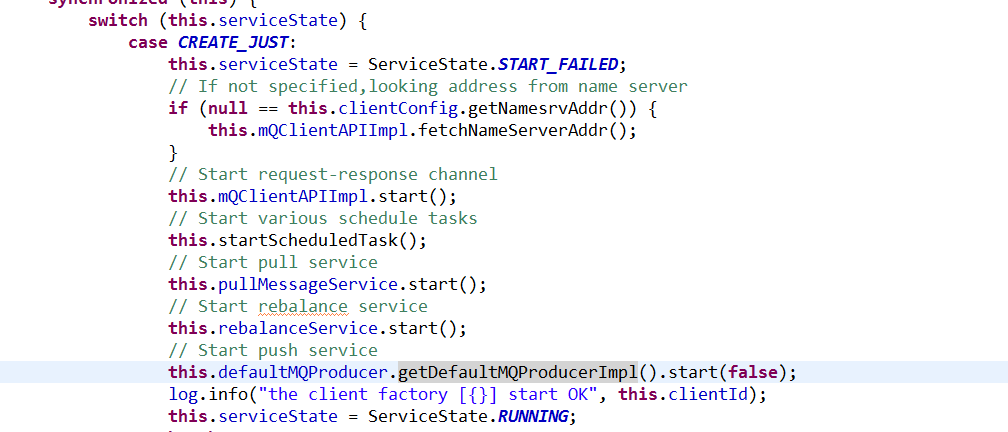本节目录
1、 RocketMQ推拉模式简介;
2、 DefaultMQPullConsumer核心属性;
3、 消息消费者启动流程分析;
1、RocketMQ 推拉模式简介
消费者与消息存储方 Broker一般有两种通信机制:推(PUSH)、拉(PULL)。
- 推模式:消息发送者将消息发送到Broker,然后Broker主动推送给订阅了该消息的消费者。
- 拉模式:消息发送者将消息发送到Broker上,然后由消息消费者自发的向Broker拉取消息。
RocketMQ 推拉机制实现:严格意义上来讲,RocketMQ 并没有实现 PUSH 模式,而是对拉模式进行一层包装,在消费端开启一个线程 PullMessageService 循环向 Broke r拉取消息,一次拉取任务结束后马上又发起另一次拉取操作,实现准实时自动拉取,PUSH 模式的实现请参考如下博文:
1、 推模式消息拉取机制;
2、 推模式消息队列负载机制;
本文重点在讨论RocketMQ拉模式DefaultMQPullConsumer实现。
RocketMQ 拉模式,RocketMQ 消费者不自动向消息服务器拉取消息,而是将控制权移交给应用程序,RocketMQ消费者只是提供拉取消息API。
为了对RocketMQ 拉模式有一个直观的了解,我们先大概浏览一下 MQPullConsumer 接口。

从上面我们可以看到除了启动、关闭,注册消息监听器,其他的就是针对 MessageQueue 拉取消息,特别值得留意的是每一个拉取 pull 方法,都是直接针对消息消费队列。PUSH 模式可以说基于订阅与发布模式,而PULL模式可以说是基于消息队列模式。
特别说明:PULL模式根据主题注册消息监听器,这里的消息监听器,不是用来消息消费的,而是在该主题的队列负载发生变化时,做一下通知。
我们应该带着我们对 PUSH 模式的相关知识来认识一下 PULL 模式,对比学习.
PUSH模式主要知识点:
- 消息拉取机制:PullMessageServer线程 根据PullRequest拉取任务循环拉取。
- 消息队列负载机制,按照消费组,对主题下的消息队列,结合当前消费组内消费者数量动态负载。
按照上面API的描述,PULL模式应该无需考虑上面两个情形,我们带着上述疑问,开始我们今天的学习。
2、DefaultMQPullConsumer 核心属性
/**
* Do the same thing for the same Group, the application must be set,and
* guarantee Globally unique
*/
private String consumerGroup;
/**
* Long polling mode, the Consumer connection max suspend time, it is not
* recommended to modify
*/
private long brokerSuspendMaxTimeMillis = 1000 * 20;
/**
* Long polling mode, the Consumer connection timeout(must greater than
* brokerSuspendMaxTimeMillis), it is not recommended to modify
*/
private long consumerTimeoutMillisWhenSuspend = 1000 * 30;
/**
* The socket timeout in milliseconds
*/
private long consumerPullTimeoutMillis = 1000 * 10;
/**
* Consumption pattern,default is clustering
*/
private MessageModel messageModel = MessageModel.CLUSTERING;
/**
* Message queue listener
*/
private MessageQueueListener messageQueueListener;
/**
* Offset Storage
*/
private OffsetStore offsetStore;
/**
* Topic set you want to register
*/
private Set<String> registerTopics = new HashSet<String>();
/**
* Queue allocation algorithm
*/
private AllocateMessageQueueStrategy allocateMessageQueueStrategy = new AllocateMessageQueueAveragely();
/**
* Whether the unit of subscription group
*/
private boolean unitMode = false;
private int maxReconsumeTimes = 16;
- consumerGroup : 消费组名称.
- brokerSuspendMaxTimeMillis :长轮询模式下挂起的最大超时时间,在Broker端根据偏移量从存储文件中查找消息时如果返回 PULL_NOT_FOUND时,不理解返回给拉取客户端,而是交给PullRequestHoldService线程,每隔5秒再去拉取一次消息,如果找到则返回给消息拉取客户端,否则超时。
- consumerTimeoutMillisWhenSuspend : 整个消息拉取过程中,拉取客户端等待服务器响应结果的超时时间,默认30s
- consumerPullTimeoutMillis :默认10s,拉消息时建立网络连接的超时时间
- messageModel :消费模式,广播、集群
- messageQueueListener : 业务消息监听器
- OffsetStore :消息消费进度管理器
- registerTopics :注册主题数
- allocateMessageQueueStrategy :队列分配器
- maxReconsumeTimes :最大消息重试次数,默认16次
3、消息消费者启动流程分析
DefaultMQPullConsumerImpl#start
public synchronized void start() throws MQClientException {
switch (this.serviceState) {
case CREATE_JUST:
this.serviceState = ServiceState.START_FAILED;
this.checkConfig();
this.copySubscription(); // @1
if (this.defaultMQPullConsumer.getMessageModel() == MessageModel.CLUSTERING) {
this.defaultMQPullConsumer.changeInstanceNameToPID();
}
this.mQClientFactory = MQClientManager.getInstance().getAndCreateMQClientInstance(this.defaultMQPullConsumer, this.rpcHook); // @2
this.rebalanceImpl.setConsumerGroup(this.defaultMQPullConsumer.getConsumerGroup());
this.rebalanceImpl.setMessageModel(this.defaultMQPullConsumer.getMessageModel());
this.rebalanceImpl.setAllocateMessageQueueStrategy(this.defaultMQPullConsumer.getAllocateMessageQueueStrategy());
this.rebalanceImpl.setmQClientFactory(this.mQClientFactory); // @3
this.pullAPIWrapper = new PullAPIWrapper(
mQClientFactory,
this.defaultMQPullConsumer.getConsumerGroup(), isUnitMode());
this.pullAPIWrapper.registerFilterMessageHook(filterMessageHookList); // @:4
if (this.defaultMQPullConsumer.getOffsetStore() != null) {
this.offsetStore = this.defaultMQPullConsumer.getOffsetStore();
} else {
switch (this.defaultMQPullConsumer.getMessageModel()) {
case BROADCASTING:
this.offsetStore = new LocalFileOffsetStore(this.mQClientFactory, this.defaultMQPullConsumer.getConsumerGroup());
break;
case CLUSTERING:
this.offsetStore = new RemoteBrokerOffsetStore(this.mQClientFactory, this.defaultMQPullConsumer.getConsumerGroup());
break;
default:
break;
}
this.defaultMQPullConsumer.setOffsetStore(this.offsetStore); // @5
}
this.offsetStore.load();
boolean registerOK = mQClientFactory.registerConsumer(this.defaultMQPullConsumer.getConsumerGroup(), this); // @6
if (!registerOK) {
this.serviceState = ServiceState.CREATE_JUST;
throw new MQClientException("The consumer group[" + this.defaultMQPullConsumer.getConsumerGroup()
+ "] has been created before, specify another name please." + FAQUrl.suggestTodo(FAQUrl.GROUP_NAME_DUPLICATE_URL),
null);
}
mQClientFactory.start(); // @7
log.info("the consumer [{}] start OK", this.defaultMQPullConsumer.getConsumerGroup());
this.serviceState = ServiceState.RUNNING;
break;
case RUNNING:
case START_FAILED:
case SHUTDOWN_ALREADY:
throw new MQClientException("The PullConsumer service state not OK, maybe started once, "
+ this.serviceState
+ FAQUrl.suggestTodo(FAQUrl.CLIENT_SERVICE_NOT_OK),
null);
default:
break;
}
}
代码@1:根据注册的主题,构建订阅信息,放入到RebalanceImpl的订阅表中。
DefaultMQPullConsumerImpl 可以注册多个主题,但多个主题使用同一个消息处理监听器。

代码@2:创建MQClientInstance,每一个clientConfig 一个 MqClientInstance 对象。
代码@3:填充 rebalanceImpl 对象的消费组、消息队列分配器、消费模式。
代码@4:构建 PullAPIWrapper 对象,该对象封装了具体拉取消息的逻辑,PULL,PUSH 模式最终都会调用 PullAPIWrapper 类的方法从 Broker 拉取消息。
代码@5:根据集群消费模式(广播、集群)初始化消息进度管理器offsetStore。
代码@6:将该消费者加入到 MQClientInstance 消费者列表中。
代码@7:启动 MQClientInstance。该方法我们在讲解 DefaultMQPushConsumer 时详细讲解过,我们再简单浏览一下该方法:

既然Pull 模式无需自动拉取消息,但 PullMessageService 线程(消息拉取)+ RebalanceService 线程(消息队列负载)这个两个线程就没必要启动,这里启动了,会不会带来问题?
答案是不会,因为虽然 PullMessageService 线程启动,但是一开始会在获取拉取任务(PullRequest)

PullRequest 是由 RebalanceService 产生,它根据主题消息队列个数和当前消费组内消费者个数进行负载,然后产生对应的 PullRequest 对象,再将这些对象放入到 PullMessageService 的 pullRequestQueue队列。具体放入逻辑调用:RebalanceImpl#dispatchPullRequest(final List < PullRequest>pullRequestList);
我们来看一下 RebalanceImpl 的子类 RebalancePullImpl 的 dispatchPullRequest 方法。

再对比一下 RebalancePushImpl 的 dispatchPullRequest。

再结合PullMessageService 被唤醒后,执行的 pullMessage方法。

我们可以得出结论,PullMessageService 只为 PUSH 模式服务,ReblanceService进行路由重新分布时,如果是 RebalancePullImpl, 并不会产 PullRequest,从而唤醒PullMessageService、PullMessageService 被唤醒后,也是执行 DefaultMQPushConsumerImpl 的 pullMessage 方法。
ReblanceService 线程默认每 20s 进行一次消息队列重新负载,判断消息队列是否需要进行重新分布(如果消费者个数和主题的队列数没有发生改变),则继续保持原样。对于 PULL 模型,如果消费者需要监听某些主题队列发生事件,注册消息队列变更事件方法,则 RebalanceService 会将消息队列负载变化事件通知消费者。
至于PULL 模式那些根据消息队列拉取消息的方法,与 PUSH 模式走的逻辑是一样的,唯一的区别是PULL 模式是需要应用程序收到触发消息拉取动作。
通过上述分析,我们总结一下RocketMQ,PUSH,PULL模式区别:
- PUSH: 消费者订阅主题,然后自动进行集群内消息队列的动态负载,自动拉取消息。准实时。
- PULL:消费者无需订阅主题,由业务方(应用程序)直接根据MessageQueue拉取消息。
项目中一般采用PUSH模式。
备注:本文是《RocketMQ技术内幕》的前期素材,建议关注笔者的书籍:《RocketMQ技术内幕》。